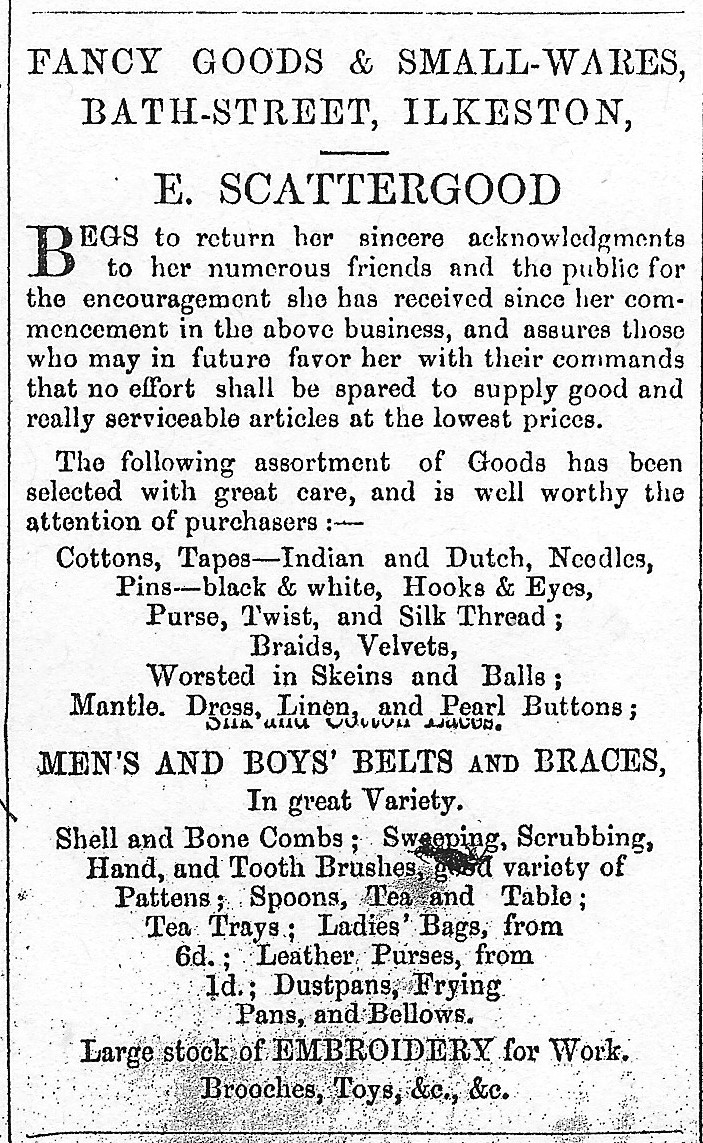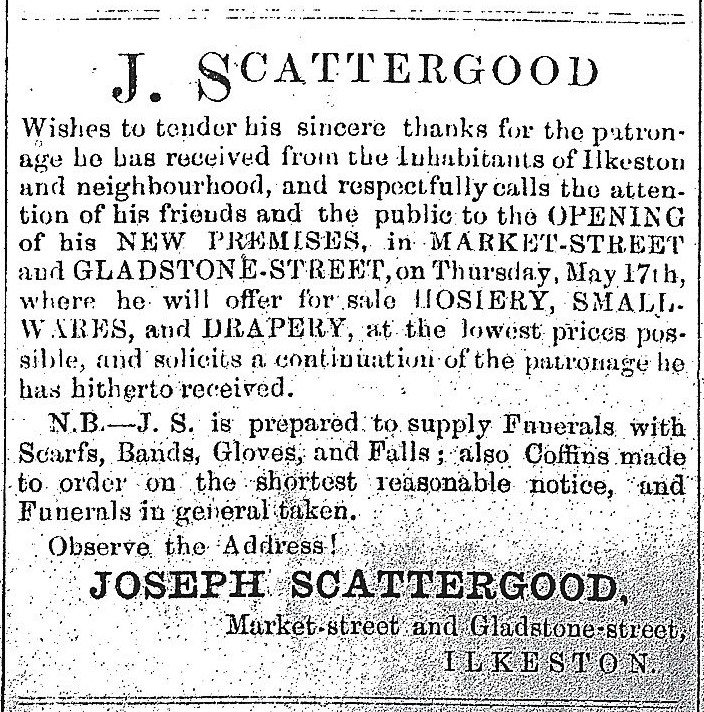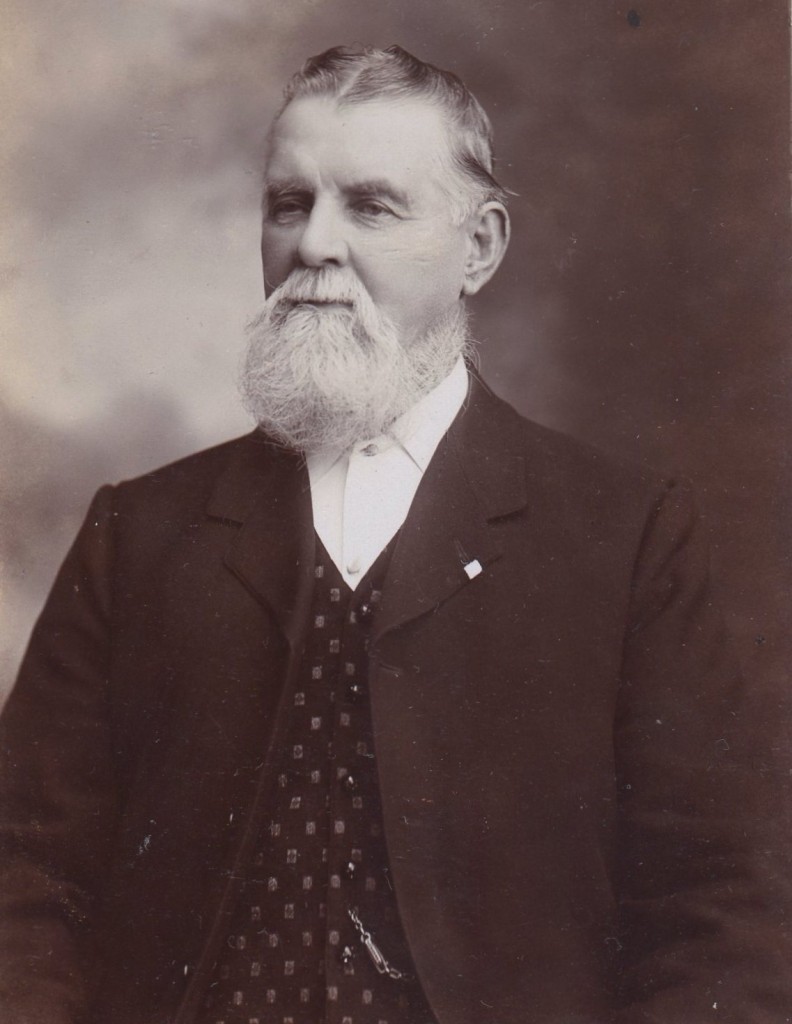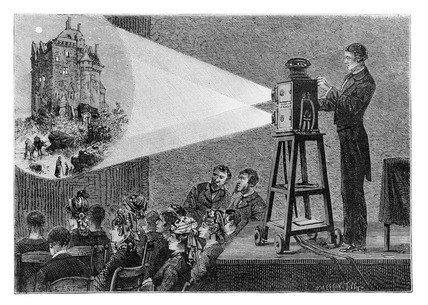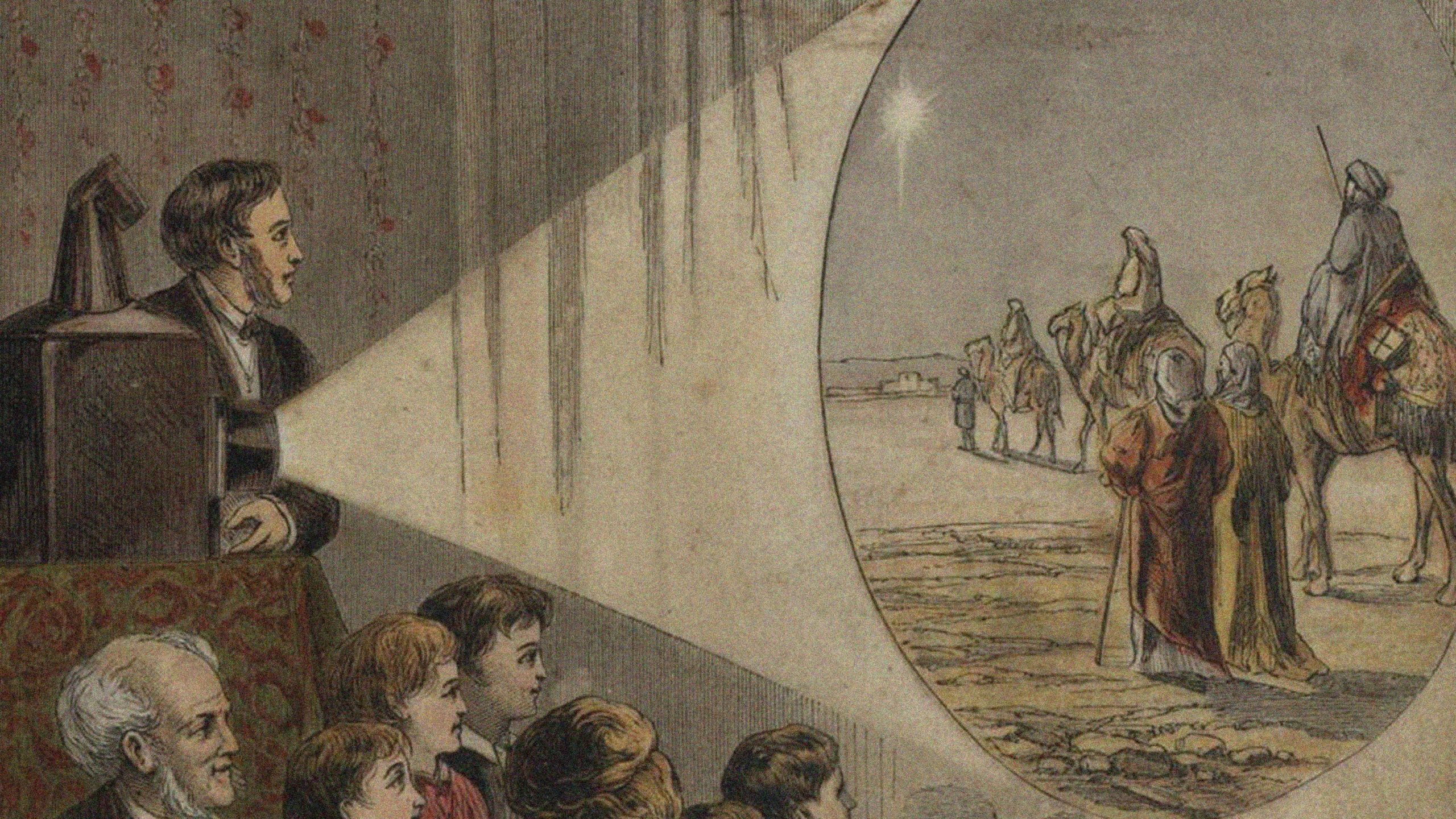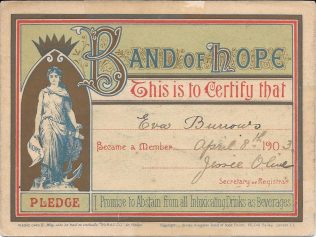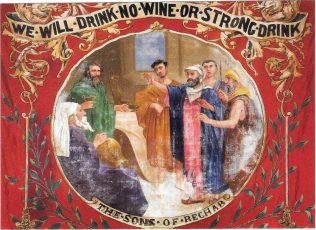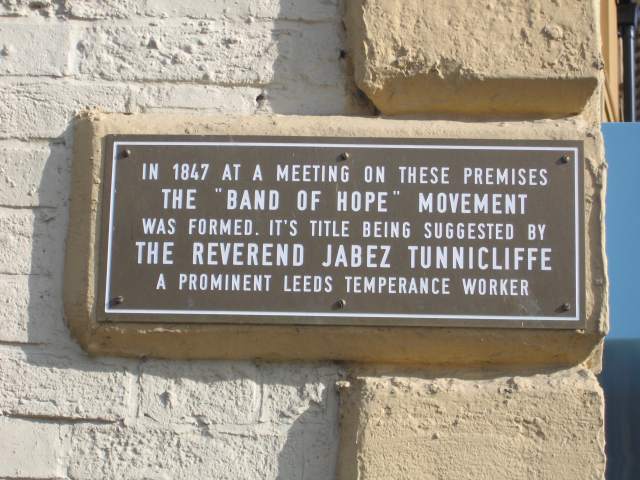After the premises of Solomon Beardsley ….
“Then came Mrs. Joseph Scattergood’s fancy shop. I remember her selling off the stock” writes Adeline.
Mrs. Joseph Scattergood was born Elizabeth Chadwick on October 8th 1834, the oldest daughter of James, grocer and ironmonger, and Ann (nee Brentnall).
On September 21st 1856 Elizabeth married wheelwright Joseph Scattergood at Ilkeston Independent Chapel in Pimlico.
Dated December 10th 1857, just over a year after her marriage, the Pioneer advert (right) shows Elizabeth’s range of products at the Bath Street store shortly after the establishment of her business there.
Born in February 1834 Elizabeth’s husband, Joseph Scattergood, was the second son of Richard, cottager and landlord of the Stanhope Arms in Stanton by Dale, and his first wife Martha (nee Smedley), and came to Ilkeston just prior to his marriage, to trade in the Market Place as a wheelwright and joiner
The Scattergoods in Bath Street 1856-1865
In 1855 Joseph had taken over the premises of the late Thomas Bennett and his son Joseph, adjoining the Old Harrow Inn, to continue his business as a wheelwright there.
By 1861 he was established at his Bath Street premises – a neighbour of Solomon Beardsley and adjacent to White’s Yard – where the census describes his wife Elizabeth as a smallware dealer while Joseph is a wheelwright.
In various later sources he is described as a furniture dealer, smallware and hosiery dealer, surveyor, joiner, builder, cabinet maker and undertaker.
In 1864 Joseph, coach builder, painter and decorator, moved from premises he occupied in South Street into Market Street.
1869- 1871; Joseph, a man of many skills
Since April 1869, on the resignation of Samuel Pounder, Joseph had served as ‘the Collector, Surveyor, Town Hall-keeper and Inspector of Nuisances’ for the Local Board. These positions required him to collect all rates and rents, the market, statute and other tolls, and issue receipts for all money given to him which was then passed to the Board Treasurer.
Barely a few days into his duties as Inspector of Nuisances, Joseph was wandering through the Thursday market at Ilkeston when his nose was drawn to the fish stall of John Harris, a poor man who ran a small business in Carter Gate, Nottingham and who set up an occasional stall at Ilkeston. Joseph decided that the fish on sale were rotten and clearly unfit for human consumption — a conclusion supported by Dr. George Blake Norman who had been called to examine them — although several people were quite prepared to purchase them. At the Petty Sessions, the fishmonger was fined £4 10s and 18s costs.
Joseph’s duties as Surveyor and Inspector were printed in the Bye-laws. Under him was a ’Foreman of the Men’ responsible for the workmen employed by the Board and who delivered their time sheets every Friday to the Surveyor.
And as Town Hall-keeper he was the security officer, cleaner, ‘health and safety’ superintendent, and odd-job man for that building — charged with its opening and closing as required, cleaning it, caring for its furniture and fittings, making the rooms warm when required, whilst guarding the place from fire and other danger. He had to attend whenever the Hall was open for public meetings and concerts, and preserve order at those events.
Joseph’s reward for these many duties was a salary of £50 per annum and rent-free accommodation in the house next to the Hall — No 2 Market Place – where he was at the time of the 1871 census. (Although when he was appointed Joseph did have to supply a bond of £200 to the Board.)
In 1869 Dr. George Seaton Buchanan became one of two full-time inspectors for the Medical Department of the Privy Council whose job it was to carry out inspections into local outbreaks of disease.
And in the following year that same inspector brought into serious question the efficacy of Joseph’s work as Surveyor and Inspector of Nuisances.
Buchanan’s report on the Sanitary Condition of Ilkeston caused the doctor to forward a complaint to the Secretary of State for the Home Department.
He had discovered that ‘excremental pollution’ was widely diffused in the water of the town, leading to the prevalence of fever. Also cited were ‘ill-kept roads and unclean channels’, overflowing ashpits with filthy refuse, and pig-styes far too close to cottages.
The report indicated that Joseph had far too many tasks to fulfil — he could not be expected to survey, inspect and collect without reducing the effectiveness of his work..
In August 1871 a report by England’s chief medical officer John Simon noted that at Ilkeston enteric fever was found to be endemic, air and drinking water was polluted by excrement, ashpits were filthy and drainage imperfect.
1872; It all becomes too much for Joseph
Perhaps all of Joseph’s ‘multi-tasking’ was some excuse for what happened shortly after.
Irregularities were found in Joseph’s account books and questions arose over his competence in collecting rates and fees and in keeping accurate and reliable accounts.
Because of his misdemeanours — whether caused through carelessness, under-training, overwork, lack of qualifications – Joseph received little sympathy in the pages of the Pioneer, always strongly opposed to the Local Board when it was dominated by Liberal (‘Yellow’) members.
And of course, there was always an anonymous letter-writer on hand to ram home a point. On this occasion the obliging correspondent was ‘J.P.S’.
Sir – The Board are at last obliged to admit the irregularities of their pet yellow Surveyor, but Sir, how is it that eighteen such clever gentlemen as we have on the Board, though they profess to have met weekly to look over his accounts, should not have detected such irregularities before.
“It is well-known that his labour sheets and books have never properly been kept: that he was not able to do it; the Board are therefore themselves as much to blame for the deficiencies as their Surveyor, and ought properly and individually to share the loss and the expenses of audit. The ratepayers cannot help putting the question “how is it that at every monthly meeting the Clerk has reported his examination of the Surveyor’s accounts and that he found them correct; and now, all of a sudden, owing to the query of a new member, they are found to be in a muddle and incorrect?” This surely proves either the incapacity or the inefficiency of the Clerk.(This was Wright Lissett) It is his duty to see that the accounts of the Surveyor are correct; and if they are not correct he ought to make them so.
“Who is to pay the expense of the audit? Certainly not the parish, but the gentlemen who engage servants who are unable to discharge rightly the duties of their station. It is really amusing to see the ignorance of such wise men as the Chairman and Mr. Smith, who admit they did not know on what terms they had engaged the Surveyor. Would they admit such ignorance in their own affairs? The Board may well be in such difficulties when their business is ‘bungled’ in such fashion.
“As the Surveyor has been so ‘shamefully’ underpaid for having failed to do those things which he ought to have done, and for having done those things which he ought not to have done, we may expect to learn that the deficiencies will be cancelled, and that a meeting of the sympathising members of the Board will be held at the sign of the ‘Yellow Hammer’ to present their pet with a gold watch and chain, &c.”
(March 14th 1872)
I’m not sure about the watch and chain, but in March 1872 Joseph tendered his resignation which was eagerly accepted by the Local Board, though some members wished to dismiss him.
Presumably he would have then left his ‘grace and favour’ house in the Market Place.
Joseph was succeeded in his duties for the Local Board by William Attenborough, second son of the late Mark Attenborough, proprietor of the Sir John Warren Inn.
1875; A fresh start for Joseph
By November 1875 Joseph was trading at 72 Bath Street, opposite the Rutland Arms Hotel.
Shortly after this he began to erect new workshops in Market Street and in January 1877 he was advertising the opening of these new premises in Market Street and Gladstone Street, offering for sale “hosiery, small wares and drapery, at the lowest prices possible” — he added that he would also supply funerals with “scarfs, bands, gloves and falls” and promised “coffins made to order on the shortest reasonable notice”.
In May 1877 Mrs. Elizabeth Boustead, a newsagent but also trading in hosiery and smallwares, moved into Joseph’s old Bath Street shop – as Joseph and family now moved into their new home in Market Street/Gladstone Street.
In June 1878 Joseph was expanding his ‘empire’, and looking for builders to help with the erection of six cottages in Gladstone Street.
In later life the Scattergood couple continued to live in Market Street and Elizabeth died there, at Spring Villas – at the junction of Market Street and Gladstone Street — in August 1881.
At this time Joseph was a prominent member of the Temperance Society in Ilkeston and, as such, would regularly attend licensing sessions at the Smalley Division (held at Heanor) — and there he would consistently oppose applications. And this appears to have exasperated and exhausted the patience of some magistrates. For example, in August 1888, at the Heanor licensing sessions, Joseph’s objections resulted in the magistrate Robert Wilmot Sitwell announcing (and I paraphrase) ” Mr Scattergood, the views which you put forward are more appropriate for the House of Commons than for this court. Our duty is not to denote what the law should be but what it is !! We sit to administer the law, not alter it”.
1889; Third time lucky
In November 1889, for the third time, Joseph attempted to win a seat on the Town Council (formed in 1887). Councillor William Merry had just been created an’ Alderman’, leaving a vacant seat in the South Ward of the Council. Standing as a ‘Liberal’ (or Radical as the Pioneer liked to describe him), Joseph was up against Samuel Richards, a grocer in Cotmanhay Road, and an ‘Independent’. It was thought that it would be a close contest, and although Samuel had 352 votes cast for him, Joseph turned out to be a very clear winner — with 429 votes.
1890; Joseph has a second wife
In 1890 Joseph married his second wife — widow Maria Henrietta Spencer (nee Cotterill) — and continued to live at Spring Villas into the next century.
Joseph Scattergood about 1887 (courtesy of Ilkeston Reference Library)
1891; Joseph and his Amazing Magic Lantern
From the early 1870’s Joseph was a ‘patron’ of the magic lantern entertainment.
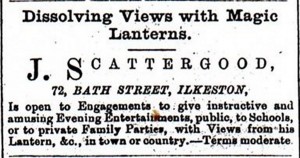
From the Ilkeston Pioneer November 18th 1875.
Joseph would treat delighted audiences around the town to his shows.
That is, until November 18th 1891 when, at about 7.30 pm, during a performance to an audience of about 100 at the Methodist New Connexion Chapel in Stamford Street, the hydrogen gas flow to his oxy-hydrogen lantern developed a problem which Joseph noticed — though he could recall little of the events which followed.
However many members of his audience certainly could !!
There was a terrific explosion, windows were blown out, holes were made in the floor and Joseph was sent flying over two rows of chairs. There was a crash of falling glass, piercing screams, followed by complete darkness in the hall and a mad dash for the exit doors. Of much more consequence, however, was the injury to 15 year-old Hubert Brewer, a messenger at Manners Colliery and son of Charles and Ann (nee Tremlin) of Burr Lane. He was found lying on the floor of the chapel, bleeding from a wound in the forehead, his clothes nearly blown off his body by the blast. Though he was rushed to the Cottage Hospital, Hubert was dead before he arrived there. Serious injuries were sustained by several other members of the audience, including the dead lad’s older brother, John. Mary Ann Slack (nee Holmes) of Lodge Row who suffered serious wounds in her face and to her eye, which was lost. A similar injury was suffered by Clara Summerfield of Stamford Street, the doctors at the hospital fearing that she would also lose the other eye.
The next day the Nottingham Evening Post described the scene of the disaster:
“Every window in the sides of the chapel has been been completely demolished, and the end windows have been bulged out and slightly broken. The chapel is at least 30 feet high, but such was the force of the explosion that the plaster was torn from the ceiling in several places. The floor is strewn with broken glass, plaster, fragments of wood, portions of clothing and hats, while in many places it is besmattered with blood, as are some of the chairs as well. Several chairs which stood in front of the lantern are smashed, and there is a large hole through the floor, evidently caused by the falling weights after they had been lifted into the air. (The gas was contained in an indiarubber bag within a wooden framework, on top of which were two 56 lb weights)
The lantern lies on the floor, and pieces of the cloth which covered the table have been blown to the ceiling. A man’s silk hat has nothing but the rim left, and an umbrella has been blown to fragments. Pieces of wood forming the framework of the oxygen bag lie in all directions, and one piece which was blown into the gallery 20 yards away smashed the double bass.
The lantern slides lie among the débris, while the way in which the chairs have been thrown down and upon each other furnish evidence of the panic, which added to the injury caued by the explosion. Had the building been less lofty it is almost certain the roof would have been lifted off”.
A few days later, at the inquest into the death of Hubert, Joseph Scattergood gave details of the convoluted and intricate mechanism of the lantern. For the light, an oxy-hydrogen limelight was used, with two bags attached, one containing oxygen, prepared by Joseph at his home, and one with hydrogen, procured from the chapel. The hydogen bag was fixed to the gas-bracket, after which the canvas screen was erected around it. The lantern was fixed ‘at the proper distance‘ and both bags were then sited between the pressure boards, with the hydrogen at the bottom, then a canvas covering, and then the oxygen bag on the top. The boards were then strapped tightly together, following which, the gas bags were attached — the hydrogen pipe was to the left hand of the dissolver. Two 56 lb weights on top of the pressure boards held them securely. He saw nothing wrong with either the bags or the connections, and the jets were already adjusted. New lime was then placed on the top lantern, and the hydrogen bag was turned on to heat the lime, lighting the gas inside the lamp. The same process was repeated with the bottom lantern. It was while he was configuring the flow of the gases to the lantern that Joseph heard an ominous crackling within the tubes; this was followed by a thunderous explosion and he could remember no more !!
Various experts were called to postulate the reason for the catastrophe, one suggesting that, because of the frequency of such accidents, the use of gasbags should be discontinued and cylinders should be substituted, something which would entirely prevent such accdents in the future. After reviewing all of this, the inquest jury decided that the explosion was purely accidental, and that Joseph had used all the usual and necessary precautions. It recommended the use of cylinders, as suggested. ‘No more gasbags’ was the cry !!!
Such was the interest in Ilkeston, over this disaster and the following inquest, that copies of the Ilkeston Advertiser ran out, leaving hundreds of potential readers disappointed. A special edition, printed after the first, also sold out.
After a ceremony at the Bath Street Wesleyan Chapel where Hubert was a member of the school choir, he was buried in Stanton Road Cemetery on a Sunday afternoon. His gravestone read … “In affectionate memory of Hubert, the beloved son of Charles and Ann Brewer who was killed at Stamford Street Chapel, November 18th, 1891, aged 15 years”
On November 30th, a fund was established to receive subcriptions, the proceeds of which were to help those injured in the explosion — so long as they did not take legal action for compensation against Joseph. The first on the list of donations was that from Joseph Scattergood for £20 !!
The Magic Lantern entertainment had been in aid of the Pleasant Sunday Afternoon Fund !!! This movement was inaugurated at Ilkeston on October 19th, 1890, at a crowded Town Hall meeting, presided over by Joseph. Its aim was to bring Christian teaching to mainly working class groups in an ‘acceptable, usually short, form‘.
In less than a year the Society was embroiled in controversy when its secretary, John Fogg, was found guilty of embezzlement — that is, of taking 1s from his employer, Thomas Martin, furniture dealer, at his branch shop in Ilkeston. Although the amount was small, the sentence was pretty stiff — six weeks in prison with hard labour.
The scandel led to the PSA being’disbanded’ but not permanently. It was resurrected in October 1893 under the title ‘The Brotherhood’.
As a consequence of the Stamford Street tragedy, such lantern presentations in Ilkeston were temporarily halted. It was only in May of the following year that the town’s Photographic Society recommenced its lantern exhibitions, with one in the Town Hall, showing slides of ‘Scotch scenery, the Manchester Ship Canal, engineering etc..’
1890-1896; Temperance Joseph
Joseph led a teetotal lifestyle — very vocally. When the Compensation Clauses in the Local Taxation (Customs and Excise Duties) Bill were being discussed in Parliament in the summer of 1890, Joseph was a leading figure in the local opposition to them. As their name suggests it was proposed that any landlord who wished to leave the liquor trade could seek financial assistance to do so, payable out of County Council public funds.
In late June Joseph chaired a public meeting in the Market Place to voice opposition. Public houses should be closed without compensation !! The sober part of the community had had to pay increased costs of police, prisons, lunatic asylums, workhouses, all because of the drink trade !! They should be compensated, not publicans !! The meeting passed a resolution urging the Government to withdraw these clauses.
About two weeks later there was a Temperance demonstration in the town, again prominently featuring Joseph, but this time in celebration — of the defeat of the Government’s licensing proposals. A procession was formed, of the Bands of Hope of all the town’s Methodist and Baptist chapels including many children, of Rechabites, and members of the British Women’s Temperance Association, with banners and flags, and led by the Temperance Brass Band, which tramped the main streets. It eventually came to rest in the Market Place where four large railway drays had been formed into a platform for a choir and the main speakers, chief among them Joseph, President of the Ilkeston Band of Hope Union.
In May 1893 a new Temperance Hall and reading room was opened in Bath Street, close to the Wesleyan Chapel there. Made of wood it had cost £100 with an estimated £100 to be spent — the final cost was in fact just over £260. The building had a hall, 20 yards long and about six yards wide, with a small room beneath for the sale of temperance literature. Joseph and his second wife Maria had been the motivating forces behind its establishment. And in the following month it was granted a music licence after a successful examination by the Borough Surveyor.
At that time there were 49 public houses in Ilkeston.
The problem for the Temperance movement was that its new headquarters were within the property bounds of the Wesleyan Chapel which might, at any time, reclaim it for the chapel’s own purposes. Another site which could provide a more permanent home was required. And there was still an outstanding debt to be paid off on the bill for building the recent wooden Hall. Some serious ‘fund-raising’ was required !! What better solution than to call on the Temperance Ladies ?!! On April 25th 1894 their Grand Bazaar was opened.
Present at the opening was an impressive list of local dignitaries… the Mayoress, the vicar of Holy Trinity Church and his wife, Joseph Scattergood and wife (of course), the wife of the Vicar of St. Mary’s, the Woolliscrofts, many Town Councillors … and several ‘out-of-town worthies’. They were there to buy, not to talk, and so the Rev. Binney kept his remarks short as he introduced Mrs Boden of Derby to open the bazaar, Unfortunately she didn’t quite keep to the script and got a little carried away with a speech which was anything but short !!
Held inside the wooden hall, items were ranged along both its sides —an art gallery, a museum, a stereoscope, a gipsy fortune teller, a refreshment stall, a fishpond — and £40 was taken on the first day. It continued into its second day.
Three months after the bazaar and Joseph was back at the Temperance Hall, but this time in the chair of an anti-vaccination meeting. And a few weeks later he was standing in the Market Place addressing a similar meeting, at which a resolution was passed calling upon Ilkeston’s M.P. Sir Walter Foster to support the repeal of the Vaccination Acts.
See — https://www.myprimitivemethodists.org.uk/content/category/subjects-2/temperance
To some, temperance simply meant moderation, and for them that was not enough … it was either the whole hog or none. Thus, abstinance was what was required. There were so many local examples to prove the point.
For example, on January 12th 1893 William Milnes, a cab owner of South Street, was driving his four-wheel conveyance along Rutland Street at one o’clock in the morning, returning from a local ball, with a police officer on the box beside him. He felt the vehicle going over an obtacle and quickly stopped. The P.C. got down to investigate and discovered labourer John Hadley, lying in the road; as well as being severely injured, he appeared starved and benumbed. Putting him in the cab, they rushed to the cottage hospital but John died shortly afterwards.
At the nearby Durham Ox Inn the same day, the inquest jury returned a verdict of “accidental death” and expressed an opinion that John would have frozen to death if he had not been run over — so, that was alright them !!!
This episode proved to several zealots that ‘excess drinking’ was the real culprit. “The stupifying influence of strong waters” had caused John to collapse in the middle of the road, “and in his soddened state of mind was unable to rise again. There he lay in the fog and frost … thus another drunkard met his death” (The unwritten conclusion seemed to be “and good riddance !!)
At the end of November 1894 a Temperance Sunday was in the calendar, celebrated at several venues around the town, one of them being, of course, the Temperance Hall. There a talk on ‘Our National Drink Bill’ was given and some startling ‘facts’ revealed.
The average yearly consumption of foreign wine was 15,897,867 gallons, of spirits was 30,520,807 gallons, and of ale and beer was 1,021,630,618 gallons.
For every man, woman and child in the country, this amounted to half a gallon of wine, more than a gallon of spirits and 30 gallons of ale … enough for a canal three yards wide and three yards deep from Land’s End to Scotland. Each of them on average would spend £4 10s on drink, nearly £20 for every family. This was enough to pay off the National Debt in five years.
With that money, 38 golden sovereigns could be placed on every letter in the Bible.
The corn used to make the beer would have fed 11 million people with bread.
And if all the beershops and public houses were laid end to end they would stretch from John o’Groats to Land’s End.
What a waste !! The only duty of a faithful Christian was total abstinence for the individual, and prohibition for the nation.
June 1896 … time moves on — and so does the Temperance Hall !! Because of the development of the new Wesleyan ‘Temple’ in Bath Street, the Temperance movement had lost its site there. Their hall had been forced to move into Wilton Place, to the rear of the Brunswick Hotel and this relocation spurred a new application for a music licence for the new premises. No dancing of course. Application granted.
Although the Movement was in serious debt the site was purchased and a new wooden building was constructed. It was of single storey, 64 feet long by 17 feet, and came courtesy of the efforts of Joseph, Charles Woolliscroft, Joseph Briggs and other supporters. The reopening service took place on September 16th.
February 1899 …. the Temperance Movement was still strong and active, and still meeting in its Wilton Place hall. There, in February 1899, the Ilkeston and District British Women’s Temperance Union held its quarterly tea and meeting. They were honoured by the prescence of the Rev. J Spivey who had come to talk mainly about the Inebriates Act. This had come into force on January 1st 1899 and allowed inebriates who had not committed a crime to enter a reformatory for up to three years, so long as they had been arrested and convicted of drunkenness four times in a single year. Criminal inebriates were also included if they had been convicted of an imprisonable crime. No payment by the inmate was required. This replaced the Habitual Drunkards Act of 1879 which required payment. The speaker was scornful of the whole approach to drunkards taken by the Government, and suggested the only remedy was to shut the doors of the public houses !! (much applause)
—————————————————————————————————————————————————–
1895: The Band of Hope
on Bridge End building, next to Leeds Bridge, Leeds, in which the Band of Hope was founded in 1847. (by MaxHund)
In October 1895 the Ilkeston Band of Hope held a Quarterly Meeting at the Temperance Hall where Joseph Scattergood was the Chairman. Before a mixed audience of men and women, old and young, he mentioned that he had been connected with the association for 27 years and then invited 19-year-old Brice David Knott to read his paper on “How to conduct our Bands of Hope”. Brice began by explaining the qualities needed for a Band of Hope leader — a character beyond reproach, a man kind, gentle and loving. The meeing room should be nicely decorated with beautiful mottoes. Meetings should be held weekly all the year round on the same night. There should be a committee of truly dedicated officials. He advocated a night for children’s games, with football or cricket clubs affiliated to the Band. In the discussion which followed, some expressed scepticism about the introduction of football, although others felt it better to organise these clubs themselves rather than risk the danger of outside influences leading the children astray.
Brice was the son of George Knott, grocer of St. Mary Street and member of the School Board.
1896: a second and third Joseph Scattergood
One place which Joseph would never be found was the Great Northern Hotel on Cotmanhay Road. But it was there — on October 13th 1896 — that the inquest was held into the death of Joseph Scattergood. This Joseph, son of Thomas and Jane (nee Stenson), was a collier, aged 42, who lived close by the hotel, and hadn’t worked for two years because of an aneurysm of the throat. At times the pain it caused was so great that Joseph had difficulty breathing. This was the case on the night of October 11th when the collier felt he would suffocate. He sat on a chair by the back door and made a small cut in his neck with his penknife, perhaps hoping to open the airway. Sadly he cut a large artery, blood spurted out and Joseph was dead soon after. “Death from misadventure” was the verdict from the inquest.
And about six weeks after Joseph’s burial a third Joseph Scattergood was found drunk and disorderly in the town and was hauled into the Petty Sessions. Needless to state (but I’ll state it nonetheless) this was not ‘Temperence Joseph’ but was the 20-year-old illegitimate son of Ann Scattergood (nee Bostock), the estranged wife of John Scattergood, and William Pilkington. This was young Joseph’s first offence and so he was lightly punished — a 5s fine, inclusive of costs.
1904; Happy Birthday Dear Joseph
At the end of February 1904 a crowd of well-wishers assembled in the Temperance Hall to celebrate Joseph’s 70th birthday … and the eighteenth year of his presidency of Ilkeston’s Band of Hope Union. Towards the end of the celebration Joseph was presented with ‘The Life of Gladstone’ by John Morley. Joseph responded with a short speech … he had a lot to be thankful for, and he was thankful. He was thankful to the Giver of all good, especially when his mind ran back to the surroundings of his boyhood days. He was brought up in a public-house (the Stanhope Arms in Stanton-by-Dale), reared among the fumes of drink and the attendant debauchery. It was 33 years or more since he had signed the temperance pledge and God had given him grace so that he had never violated that pledge. He recalled that it was 33 years since the first Band of Hope was formed in the Market Street chapel, and he couldn’t have wished for a better gift. All were pleased with the evening then ?
Joseph died in Market Street, in December 1919, aged 85. Sadly for him, all his children had died before him.
—————————————————————————————————————————————————–
Adeline remembers that … “the Scattergood’s eldest daughter was named Lilly”.
The first two children of Joseph and Elizabeth Scattergood were Jane Elizabeth and Lavinia Ann, both dying in infancy.
Thus Elizabeth Ann (Lilly?) was the elder surviving daughter, with her sister Matilda Jane born three years later in December 1863.
Son Frederick Thomas was born in December 1861 but he too died in infancy.
Elizabeth Ann and Matilda Jane, married bothers John Edward and Thomas Herbert Pickworth respectively, both Lincolnshire wheelwrights whose family had moved into Cotmanhay in the 1870‘s.
—————————————————————————————————————————————————–
Adeline then continues the story of this shop …. “Afterwards the shop was taken by Mrs. S. Beardsley, one side being used for confectionery, the other for under-clothing.
The small shop was taken by Mr. George Domleo, of Long Eaton, and opened as a bookseller’s and stationer’s business”.
George Domleo took over the former Scattergood shop at the top of Bath Street when he arrived in Ilkeston about 1870 shortly after his marriage to Eliza (who?)
Born in 1841 at Sutton Bonington, he was the son of agricultural labourer Thomas and Elizabeth (nee Wheatley) and lived his childhood there. In the 1850’s the family moved to Long Eaton where George worked in the thriving lace trade before he came to Ilkeston. Tarding at number 6 Bath Street for just a short period, George moved across the other side of the road by 1880, and was at number 114. Into his premises then moved vetinary surgeon Samuel Revill M.R.C.V.S. … and when Samuel died in 1888 I believe that jeweller Joseph Hollis moved in.
In the mid-1880’s George Domleo left the town, once again bound for Long Eaton, and traded there as a cotton lace manufacturer.
—————————————————————————————————————————————————–
And now into White’s Yard.

